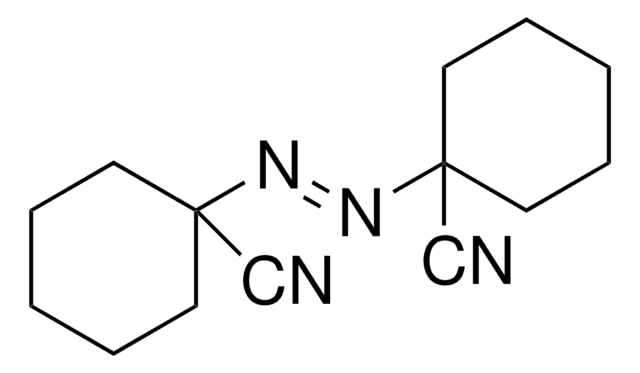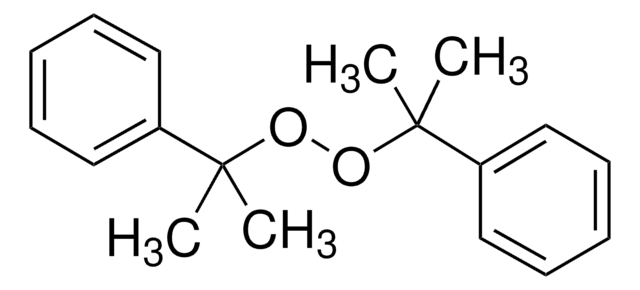11596
2,2′-Azobis(2-methylbutyronitrile)
≥98.0%
동의어(들):
2,2′-(1,2-Diazenediyl)bis[2-methylbutanenitrile], 2,2′-(Diazene-1,2-diyl)bis(2-methylbutanenitrile), 2,2′-Azobis(2-cyanobutane), 2,2′-Dimethyl-2,2′-azodibutyronitrile, 2-[2-(1-Cyano-1-methylpropyl)diazen-1-yl]-2-methylbutanenitrile, Azobisisoamylonitrile, Azocatalyst M
로그인조직 및 계약 가격 보기
모든 사진(1)
About This Item
실험식(Hill 표기법):
C10H16N4
CAS Number:
Molecular Weight:
192.26
Beilstein:
1710306
EC Number:
MDL number:
UNSPSC 코드:
12352102
PubChem Substance ID:
NACRES:
NA.22
추천 제품
일반 설명
2,2′-Azobis(2-methylbutyronitrile), also known as AIBN, is a free radical initiator that is widely used in organic synthesis for a variety of reactions. It is often used as an initiator in the synthesis of various polymers, such as polystyrene, polyacrylamide, and poly(methyl methacrylate).
애플리케이션
2,2′-Azobis(2-methylbutyronitrile) can be used as a radical initiator in the synthesis of bibenzo[b][1,4]thiazine derivatives by a free-radical condensation reaction 2,2′-dithiodianiline and methyl aryl ketones. It is also used in the synthesis of polyacrylonitrile nanoparticles via semi-continuous emulsion polymerization.
저장 및 안정성
Warning: these products are subject to the Explosives Act and must be transported refrigerated - additional costs for transport will apply.
신호어
Danger
유해 및 위험 성명서
Hazard Classifications
Acute Tox. 4 Oral - Self-react. D
Storage Class Code
4.1A - Other explosive hazardous materials
WGK
WGK 1
Flash Point (°F)
Not applicable
Flash Point (°C)
Not applicable
개인 보호 장비
Eyeshields, Gloves, type P3 (EN 143) respirator cartridges
이미 열람한 고객
Lisa Landgraf et al.
Scientific reports, 7(1), 4341-4341 (2017-07-01)
All over the world, different types of nanomaterials with a diversified spectrum of applications are designed and developed, especially in the field of nanomedicine. The great variety of nanoparticles (NPs), in vitro test systems and cell lines led to a
Julius Müller et al.
Acta biomaterialia, 71, 420-431 (2018-03-11)
The interaction of nanocarriers with blood plasma components influences the biological response, and therefore, it needs to be controlled. Whereas protein adsorption to nanocarriers has been investigated to a large extent, the role of lipid interaction for drug delivery and
Young-Gon Kim et al.
Polymers, 12(8) (2020-08-23)
The behavior of nanogels in suspension can be dramatically affected by the grafting of a canopy of end-tethered polymer chains. The architecture of the interfacial layer, defined by the grafting density and length of the polymer chains, is a crucial
Anderson M S Medeiros et al.
Polymers, 12(7) (2020-07-08)
An alternative approach for the synthesis of styrene butadiene rubber (SBR) copolymer latexes was explored in order to obtain low gel fractions and high solid contents. The ultra-turrax-assisted miniemulsion stabilized by in situ surfactant generation was adopted as the main
자사의 과학자팀은 생명 과학, 재료 과학, 화학 합성, 크로마토그래피, 분석 및 기타 많은 영역을 포함한 모든 과학 분야에 경험이 있습니다..
고객지원팀으로 연락바랍니다.









